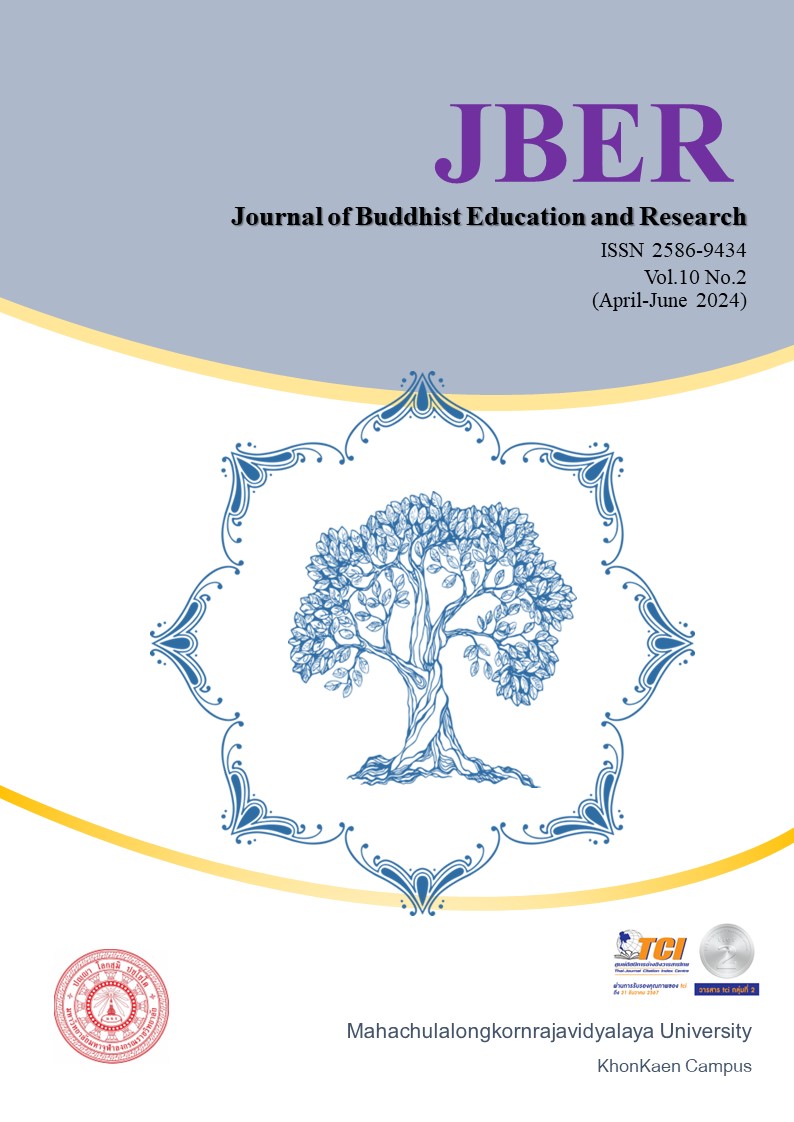UPGRADING PHRATHATPHANOM TO BE A PARTICIPATORY CULTURAL WORLD HERITAGE OF PEOPLE ON BOTH SIDES OF THE MEKONG
Keywords:
uplifting, , Phra That Phanom, participation, cultural world heritage, Mekong RegionAbstract
The objectives of this research were as follows: 1) to study the role of Phra That Phanom from the Urangkhathat legend; 2) to study Phra That Phanom with the participation of people on both sides of the Mekong River; and 3) to provide guidelines for uplifting Phra That Phanom to a cultural world heritage site. The main qualitative informants were: 1. 20 knowledgeable and local philosophers, representatives of the government, private sector, and related agencies in Nakhon Phanom Province; and 2. 15 local knowledgeable people and philosophers living in Ban Si Khot Bura, Mueang Khammouane, Laos PDR. While the quantitative informants were 100 people living in both target areas. The research tools used for the data collection were interviews and questionnaires.
The research revealed that:
1) The legend of Urangkhathat mentions enshrining the chest bone of the Lord Buddha at Phra That Phanom and being the center of faith and beliefs of Buddhists around the world. It promoted the local economy.
2) Participation in uplifting the Phra That Phanom to be a world cultural heritage site consisted of five elements, as follows: 1) setting up a committee; 2) organizing a public forum; 3) organizing educational activities; 4) exchanging information; and 5) promoting knowledge by cooperating with every related sector.
3) Guidelines for uplifting Phra That Phanom to become a world cultural heritage site were as follows: (1) Prepare an order to appoint an operating committee; (2) The province should allocate a budget to support operations; (3) Prepare an operational plan for elevating Phra That Phanom to a World Cultural Heritage Site; (4) Operate according to plan, monitor, and evaluate from government and private agencies; (5) Every process should have the participation of local people from every district in Nakhon Phanom Province along with related government and private agencies.
References
กรมศิลปากร. (2552). คู่มือการดูแลรักษาโบราณสถาน. พิมพ์ครั้งที่ 6. กรุงเทพมหานคร: สมาพันธ์.
วนิดา อินทรอำนวย. (2560). พระราชบัญญัติส่งเสริมและรักษามรดกภูมิปัญญาทางวัฒนธรรม พ.ศ. 2559. กรุงเทพมหานคร: กรมส่งเสริมวัฒนธรรม.
โกวิทย์ พวงงาม. (2545). การปกครองท้องถิ่นไทย หลักการและมิติใหม่ในอนาคต. กรุงเทพมหานคร: สำนักพิมพ์วิญญูชน.
คณะกรรมการดำเนินงานเพื่อขอขึ้นทะเบียนพระธาตุพนมเป็นมรดกโลก. (2559). ยุทธศาสตร์การขอขึ้นทะเบียนพระธาตุพนมเป็นมรดกโลก. นครพนม: วัดพระธาตุพรม วรมหาวิหาร.
จินตวีร์ เกษมศุข. (2561). แนวคิดการมีส่วนร่วมของประชาชน เพื่อการพัฒนาชุมชนที่ยั่งยืน. วารสารวิชาการมนุษยศาสตร์และสังคมศาสตร์ มหาวิทยาลัยบูรพา ปีที่ 26 ฉบับ 50 ม.ค.-เม.ย.
จิรพันธ์ จันหนิ้ว และคณะ. (2565). แนวทางการมีส่วนร่วมการจัดการศึกษาโดยชุมชนของศูนย์การส่งเสริมการศึกษานอกระบบและการศึกษาตามอัธยาศัย อําเภอลอง จังหวัดแพร่.
จุฑามาศ พันสวรรค์. (2562). การพัฒนารูปแบบการมีส่วนร่วมของคณะกรรมการสถานศึกษาในการบริหารจัดการศูนย์พัฒนาเด็กเล็ก เทศบาลนครเชียงใหม่. เชียงใหม่: มหาวิทยาลัยราชภัฏเชียงใหม่.
ทองใบ สุดชารี, (2549). ภาวะผู้นำ : กลไกขับเคลื่อนองค์การแห่งการเรียนรู้. อุบลราชธานี : สถานบันราชภัฏอุบลราชธานี.
ธนกฤต ใจสุดา. (2564). การออกแบบเครื่องประดับจากมรดกทางวัฒนธรรม. กรุงเทพมหานคร: มหาวิทยาลัยศรีนครินทรวิโรฒ.
ธัญญาลักษณ์ ใจเที่ยง. (2563). การมีส่วนร่วมของประชาชนในชุมชนเขตพระนคร กรุงเทพมหานครต่อการพัฒนาทักษะเยาวชนไทย 4.0. กรุงเพทมหานคร: สถาบันบัณฑิตพัฒนศิลป์.
สถาบันแห่งชาติว่าด้วยภูมิปัญญาและการศึกษาไทย สำนักงานคณะกรรมการการศึกษาแห่งชาติสำนักนายกรัฐมนตรี. (2542). แนวคิดและกรณีศึกษาเรื่องแนวทางการส่งเสริมภูมิปัญญาในต่างประเทศ. กรุงเทพมหานคร: บริษัททีพีพรินท์จำกัด.
สมคิด เพ็งอุดม. (2535). การศึกษาบทบาทพระสงฆ์ที่มีต่อการพัฒนาชุมชนตามทัศนะของพระสงฆ์และเจ้าหน้าที่กระทรวงหลักระดับตำบลในจังหวัดสมุทรสงคราม. มหาวิทยาลัยศรีนครินทรวิโรฒ.
สมบัติ นามบุรี. (2562). ทฤษฎีการมีส่วนร่วมในการรัฐประศาสนศาสตร์, วารสารวิจยวิชาการ ปี 2 ฉบับที่ 1 มกราคม-เมษายน.
สำนักงานคณะกรรมการวัฒนธรรมแห่งชาติ. (2552). มรดกภูมิปัญญาทางวัฒนธรรม. กรุงเทพมหานคร: กระทรวงวัฒนธรรม.
สำนักมาตรฐานการศึกษา สำนักงานสภาสถาบันราชภัฏ กระทรวงศึกษาธิการ. สำนักมาตรฐาน อุดมศึกษา และทบวงมหาวิทยาลัย. (2545). ชุดการเรียนรู้ด้วยตนเอง ชุดวิชาการวิจัย ชุมชน. กรุงเทพมหานคร: เอส. อาร์. พริ้นติ้ง.
อธิราชย์ นันขันตี. (2563). อุรังคนิทาน (ปริวรรต). นครพนม: กรมศิลปากร.
Feilden, Bernard & Jokilehto, Jukka. (1993). “ManagementGuidelines for World Cultural Heritage Sites”. Rome: ICCROM.
Goodall, J.. (1986). The Chimpanzees of Gombe: Patterns of Behavior. (อังกฤษ) https:// travel. kapook. com/view199234.html.
Jokilehto, J,. (2005). A History of Architecture Conservation. [n.p.]: Elsevier..
UNESCO, (2017). Basic Texts of the 1972 World Heritage Convention, Paris : UNESCO World Heritage Centre.
UNESCO. (2003). Intergovernmental organizations. Paris : UNESCO World Heritage Centre.
Downloads
Published
How to Cite
Issue
Section
License

This work is licensed under a Creative Commons Attribution-NonCommercial-NoDerivatives 4.0 International License.





